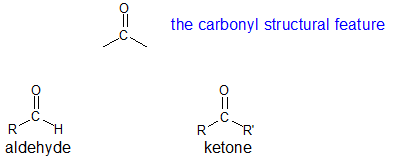19.1: Carbonyl Compound Structure and Properties
- Page ID
- 45586
The Carbonyls: the Aldehyes and Ketones
While there are several functional groups that include a carbonyl structural feature, the term "carbonyls" is used to describe aldehydes and ketones.

Aldehydes and ketones share a great deal of chemical reactivity so it makes sense to talk about these two functional groups within the same chapter. Aldehydes and ketones are both polar molecules that are H-bond acceptors. Following the "4 to 6 Rule", aldehydes and ketones with short carbon chains are soluble in water. Aldehydes and ketones are typically liquids with densities of approximately 0.8 g/mL. Aldehydes and ketones are prevalent in common household substances as shown in the table below.

Aldehydes and Ketones are Electrophiles
The carbon of the carbonyl group is electrophilic because of resonance as shown below.


